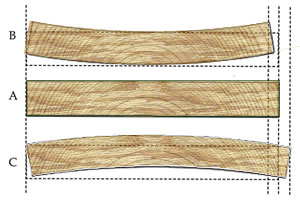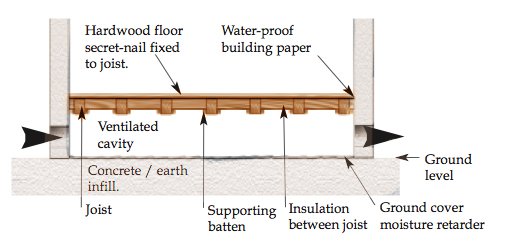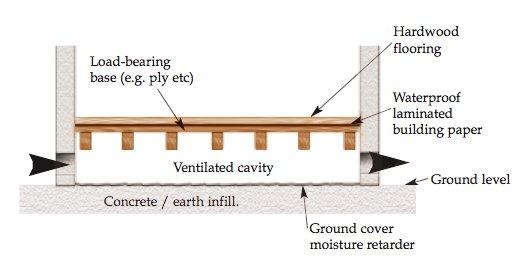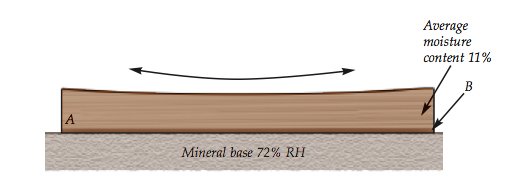We use cookies to make your experience better. To comply with the EU GDPR e-Privacy directive, we need to ask for your consent to set cookies. Learn more.
Cupping on Wood Flooring
Cupping can be described as when the floor is no longer perfectly flat but, has a slightly undulating effect with the edges of the planks being slightly raised compared to the middle of the plank, making it concave when viewed from above.
Causes of cupping
The moisture content of wood will vary over time due to its hygroscopic nature depending on the ambient humidity and temperature. As the wood gains moisture, it will expand, and conversely contracts as it loses moisture. Cupping occurs when the underside of the boards gain more moisture than the topside.
Cupped boards are often the result of moisture being gained from the subfloor over which they are laid. Because the underside has expanded due to the absorption of moisture whilst the topside has not, the plank tends to curve. This can also create extra problems in regards to the board fixing to the subfloor as they will start to lift and pull away.
Possible origins of moisture
- Inadequate drying of concrete or cement sub-floors
- Leaking pipes or faults in brickwork/walls allowing rain water to penetrate the inside of the building
- Faulty damp course
- Leaking household appliances such as washing machines and dishwashers
- Wooden subfloors with excessive moisture beneath
- Inadequate or blocked ventilation, such as air bricks in the cavity beneath suspended ground floors, with those on joists being a problem

Due to the inherent movement characteristics of wood flooring, a certain amount of cupping can be hard to avoid, particularly with wider boards.
A) Original flat sawn plank with a width of 215 mm is flat at 12% m.c.
B) The same plank has been dried to 6% m.c. It shrinks and cups as a result of greater tangential than radial shrinkage.
C) The plank then reabsorbs moisture to around 17%, this then causes it to expand and the cupping is reversed.
Diagnosis of cupping
Cement / concrete sub-floors
- Does the cement or concrete screed sub-floor have a damp proof membrane?
- What was the moisture content of the subfloor at the time of laying (greater than 75% RH)
- If the moisture content is unknown - How thick is it and what length of time did it have to dry?
Newly laid concrete screed sub-floors can take an awfully long time to dry out. To give you some idea, official guidance states that 1 day should be allowed for every mm for the first 50 mm. Thicknesses greater than that can take even longer. So, a screed with a thickness of 150 mm can take up to a year to dry out with exposure to the elements and ambient moisture potentially making this even longer.
When glued down to concrete/ cement screed
- Has the correct flooring adhesive been used? Water based adhesives can lead to cupping particularly with wider boards.
- What is the maximum width of board recommended for the particular adhesive that was used for installation?
When the subfloor is wooden such as ply or floorboards
- Is the moisture content of the wooden sub-floor greater than 12% or 2% greater than the moisture content of the solid wood flooring that has been installed on it?
- If the flooring has been installed using the nail down method, was a building paper moisture/ vapor barrier been used?
If the wooden subfloor is over a ventilated cavity - Ground floor
- Is the moisture content of the wooden subfloor greater than 12% or 2% greater than the moisture content of the solid wood flooring that has been installed on it?
- If the flooring was laid on floorboards, gaps between them could allow moisture to penetrate. Was a building paper moisture / vapor barrier used?
Diagnosis on-site
For moisture issues
- Moisture testing of both the underside and topside of the flooring is necessary to establish whether there is an imbalance. If the moisture level of the underside is greater then the source is almost certainly originating from the subfloor.
- Was the flooring, when laid, too dry for the expected, natural ambient conditions?
- If there is a cavity beneath the subfloor, test the humidity within the cavity. If this is excessive, it could be an indication of blocked ventilation, air bricks etc.
For drying issues
- Test the atmospheric humidity level. If it is below 35% RH (Relative Humidity) then the conditions could be too dry.
- Investigate whether there are sources of heat that could be leading to drying of the flooring. These might include strong sunlight from sky lights or large windows, location of hot water pipes or underfloor heating systems.
Solutions to cupping caused by excessive moisture originating from the sub-floor
Repairing of flooring suffering from cupping by means of sanding should never be carried out until the flooring has been fully dried out. If this were to happen, the raised edges of the boards would consequently be thinner than the middle of the board and when the boards subsequently do dry out, reversing the cupping effect, the edges would then be lower than the middle of the board leading to the appearance of crowning (the opposite of cupping).
- All sources of excessive moisture must be eliminated. Leaking pipes or appliances should be properly fixed, ventilation fixed or improved etc.
- The flooring then needs to be allowed to dry to the extent that it is in equilibrium with the natural ambient relative humidity. This may potentially take as long as a whole season.
- Moisture readings of a cross section of the flooring should be taken periodically to compare the moisture differential between the lower half and upper half of the flooring. If the difference is greater than 1%, further time should be allowed for drying.
- When the drying process has completed, careful sanding can be carried out to ensure that the floor is perfectly flat.
When carrying out remedial repairs of cupped floors, it is imperative to ensure the integrity of the fixing of the floor to the sub-floor, whether it be glued down or nailed down. Unfortunately, severely cupped flooring caused by excessive sub-floor moisture that has compromised the fixing to the sub-floor will sometimes need replacing entirely and so it is prudent to take all necessary measures to avoid this altogether.
Preventative measures to avoid cupping of wood flooring
- Ensure the correct humidity and moisture levels of the sub-floor.
- Where appropriate, always use a vapor barrier or damp proof membrane.
- Select flooring with the correct moisture content to suit the anticipated ambient conditions with regard to humidity and temperature.
- If ambient humidity and temperature are likely to vary widely, select flooring that is better suited to withstand such variations such as timbers with small movement, quarter-sawn materials, narrow width boards or engineered flooring products.
- Maintain, as far as possible, suitable and stable ambient conditions through the use of heating and humidifiers etc.
- Ensure proper acclimatisation of the flooring prior to installation



A.14 x 120 mm Jarrah overlay (Aspect ratio 8.5:1).
Average moisture content at time of installation 8%.
Jarrah = medium movement timber, 14% MC at 60% RH and 25°C.
B. Underside (shadowed area) has increased in moisture as it equilibriates with the mineral base causing expansion and cupping.

C. 19 x 75 mm Rosewood (Aspect ratio 4:1). Average moisture content at time of installation 10.5%. Rosewood = small movement timber, 9.5% MC at 60% RH and 25°C.
D. Underside (shadowed area) equilibriates at approximately 11.5% causes minimal expansion and no significant cupping.
Note: The timber species of the above Illustration have been chosen to demonstrate two of the factors that effect dimensional stability; the degree of movement with moisture change, and the extremes of equilibrium moisture content at the conditions specified (EMC's taken from Building Research Establishment PRL Technical Note No. 38)

